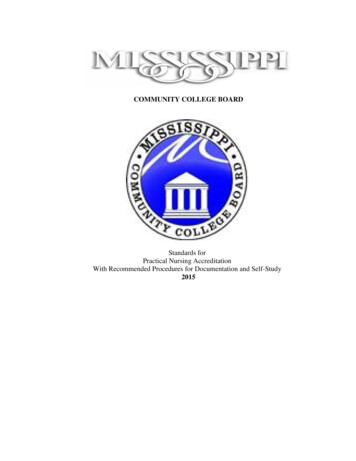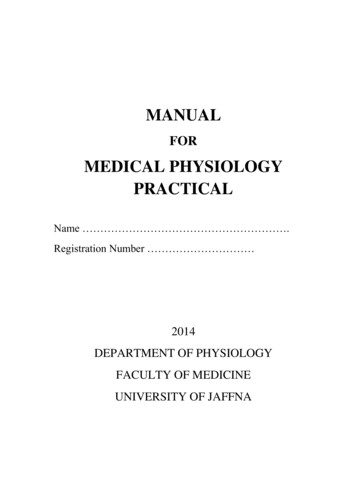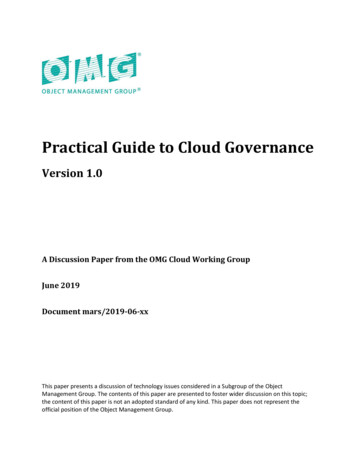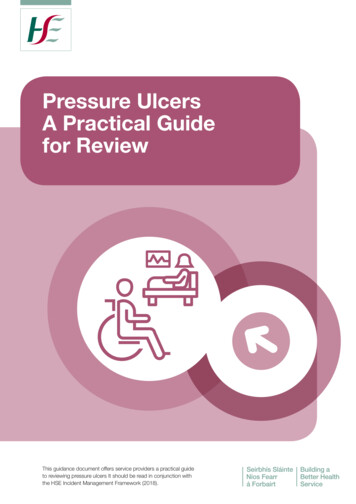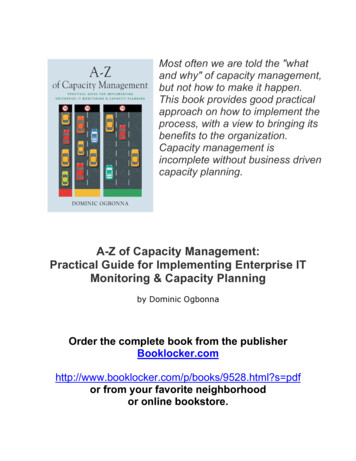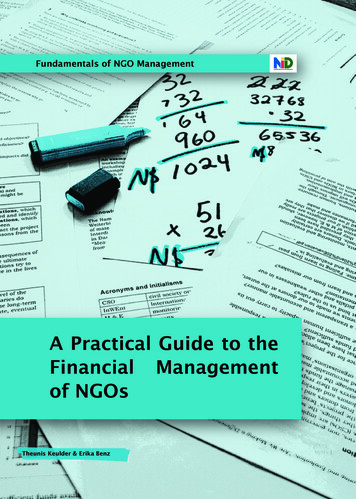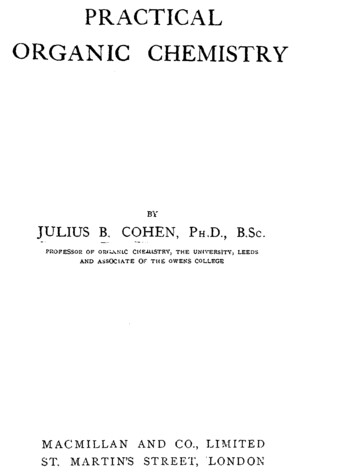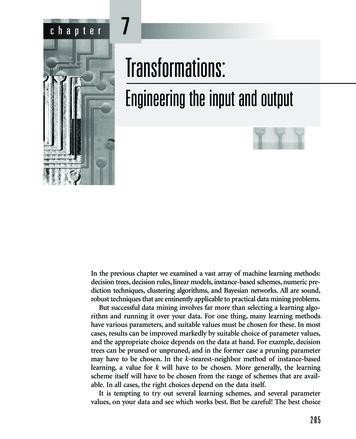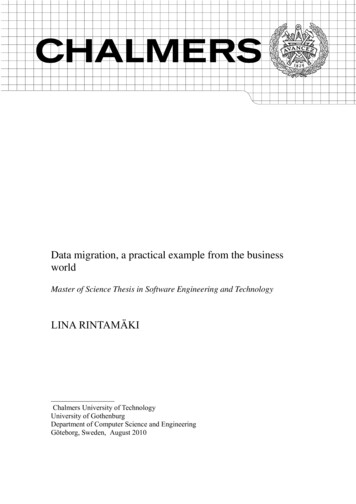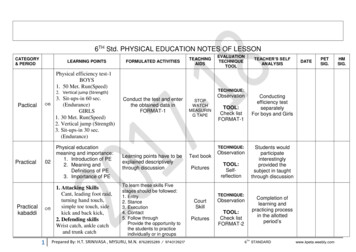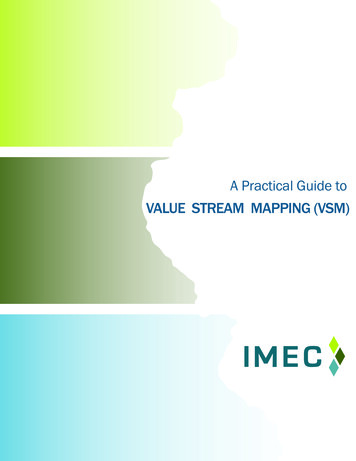
Transcription
A Practical Guide toVALUE STREAM MAPPING (VSM)
A Practical Guide to Value Stream Mapping (VSM)I don’t claim to know everything about Value Stream Mapping (VSM). However, I have used VSMextensively over the past 15 years in many different industries and situations. I believe strongly in thevalue of the tool and want to share some of my experience with the intention of helping noviceContinuous Improvement leaders head in the right direction with VSM.Index of Topics:VALUE STREAM MAPPING BASICS .2What is Value Stream Mapping? .2Why is it useful? Where does it fit in your Lean journey? .4Why do companies do Value Stream Mapping? .5How is Value Stream Mapping different than Process Mapping? .5DETAILS OF A VALUE STREAM MAP (The Document) .8Where to start / Granularity .8Creating the Value Stream Map .9What to include in process boxes .9Value Stream Mapping data accuracy / integrity .11Representing Cells .12Representing Divergent / Convergent Flows and Sub-Processes / Assemblies .13Suppliers and Customers .15Shared vs. Dedicated Resources .17Representing Inventory on the Map .17Little’s Law .18Mapping a High-Mix Process .19Identifying Waste .22DETAILS OF A VALUE STREAM MAPPING EFFORT (The Event) .22Can I facilitate the VSM myself, or should I use an outside resource? .22Characteristics of a Good Facilitator .23Planning for a VSM .24Picking a Product Family .24Who should be on the team? .25The Walk-Through .28Current State vs. Future State VSM.29How to Create the Future State .30Follow-up: .301
A Practical Guide to Value Stream Mapping (VSM)VALUE STREAM MAPPING BASICSWhat is Value Stream Mapping?Value Stream Mapping is the graphical representation of material and information flows through aprocess or service. Here is an example:CustomerInformationInformationFlowWidget Current State - 12/16/13SupplierVendor A (Al),Vendor B (Fe,Al)LT 4 weeks600 /order12-mo.Forecast,updated monthlyProductionControl(Job Boss - ERPs/w)PurchasingCustomer Takt time 450 / 121 3.6 min.Part Travel 1460' (Main Flow),1.5 miles internal w/ internal subs6.9 miles w/subcon MachiningCustomer OrdersDealersVendor C /Vendor D / Vend.E (Chinese)1x/wkSupervisorsTo SubsxShip ListDemand 18.5K/yr. (77/day)Peak Seasonal (4 months) 9,650 ( 125/day)65% special (8 day LT), 35% stock (1-2day LT) 95% on-time delivery 99% quality to customerDailyCustomerx2043 legs26.5 daysInventory1399 legs 2207 X-braces18.2 days 28.7 days287'0Bend3385 X-braces44 days1638 uprights21.3 daysFIFO – max. 20115'485 uprights6.3 days237'Weld1CT 40 sec.CT 40 sec.CT 6-8 m.CO 1 hr.CO 30 min.CO 15-30 m.Rel 50%Rel 99%Rel 99%Scrap 12%FPY 99%Batch 200-1KBatch 200-1KScrap 2%Batch 300500Bender issues(scrap, uptime)336'1CT 36 s.CO 0.5 - 5 m.Punch is at60% of rateUse of 3differentpunches215'Cut Braces72 braces0.9 daysPunch shared99813 days621'AssemblyPack101PT 6-12 m.Rel 100%Scrap 20%Weigh1CT 5 min.CT 5 min.%C&A 0CO 0 min.CO 0 min.Rel 100%Rel 100%Batch 80FPY 99%FPY 99%Batch 80Batch 80Process DataLimitedforktruckavailabilityLack of tooland materialorganizationUnmanagedinventoryProcess BoxShipRel 100%CT 20 sec.Batch 80High WIP4365.7 daysShrinkWrap11CT 10-15 m.25 per AframeBatch 80CO 5-10 m.Not all rackshave wheels000DifferentdeburrrequirementsWeighing notvalue-added,but deemednecessaryLack of awork cellHigh traveldistancesMaterialstorageManytouches perproductTravel time andmany trips,unplanned tripsto 301WIP 46.3 days (low) to 91.4days (high)Process Time 33 – 46 min.Rel 99%FPY 99%Batch 200Waste/ IssuesInventories expressed in equivalent FinishedWidgets2
A Practical Guide to Value Stream Mapping (VSM)Getting started in VSM can be daunting. Learning to See was written by Rother and Shook in 1998 andeven though it is a rather simplistic book on VSM, it is a great starting point. It does a good jobexplaining the mechanics of creating a VSM. However, it does not answer many of the questions I’ve hadto figure out through all the variations of VSM I’ve encountered. I hope to share some of what I’velearned through this forum.What VSM is not: VSM is not observing and documenting an individual doing their work. A work studymay result as an action from a VSM, but VSM is meant to span multiple functions / workstations.What VSM shouldn’t be: A VSM should not be a team of one collecting data to fill in the blanks. While itmay technically be a VSM, there is little benefit from this. The benefit comes from the collaboration,discussion, arguments and sharing of ideas that can only come about in a team environment. VSM is theformat that provides focus for this teamwork.3
A Practical Guide to Value Stream Mapping (VSM)Why is it useful? Where does it fit in your Lean journey?I have trouble imagining an organization not finding benefit in using VSM. It is a flexible, easy-to-usediagnostic tool that does a tremendous job of representing a process from start to finish. It’s visual, easyfor most people to follow and understand, and promotes focused discussion, brainstorming andproblem solving among a diverse group of participants. It has been used successfully in manufacturing,healthcare, banking / financial services, insurance, education, non-profits and many more industries.When starting a lean journey, VSM should be one of the first activities taken. Prior to VSM or any otherlean initiative, it is a good idea to set up a Lean Steering Committee or another guidance entity formanagement support and direction. This will help focus lean efforts on issues and opportunities that willhave the most impact the business. The Lean Steering Committee will help direct which product familiesto focus on first, allocate resources, set scope & boundaries and will be a sounding board for suggestionsresulting from the VSM.VSM allows a team to see the big picture and focus on what will have most impact on the entire valuestream. For example, without VSM, a business may focus on improving productivity of a non-bottleneckmachine. Amore impactful solution would be to reduce setup time on a primary piece of equipmentwhich currently drives a very large batch size and excess inventory (and lead time) throughout theprocess.If a business has limited lean exposure, it is a good idea to precede VSM with an introduction to leanprocesses via educational workshops like IMEC’s Lean Overview with Simulation, a book club, tours ofother lean businesses, etc. At minimum, you want to have the VSM core team familiar with Value-Add,Non-Value-Add, 8 wastes, and the lean tools (SMED, 5S, Cellular, etc.).You don’t have to start with VSM. 5S is also a good place to start a lean journey. It is easy for everyoneto comprehend; it allows for mass participation and it’s a foundation for many other lean tools. It drivesdiscipline (if it’s not already there), and the results are immediately noticeable and often dramatic. 5Sand VSM can be done in parallel, but both should be tools used early in your lean journey. A VSM mayhelp determine which areas to focus your 5S efforts on.4
A Practical Guide to Value Stream Mapping (VSM)Why do companies do Value Stream Mapping?In practice, I’ve found the reasons for conducting VSM fall into 3 categories: Critical Issue, See WhatSticks and My Boss Said to Do It.1) Critical Issue (Goal or Opportunity): When a business has a crisis or a tremendous opportunitythat needs involvement from multiple functions / departments, VSM is a great tool to geteveryone on the same page, focusing on solutions that will be of most net benefit to the entireorganization. These VSMs usually get a lot of attention and a lot of management support. If it’s acritical business issue / opportunity, management will allocate time and first class resources toget the project done. You generally get a great team fully engaged because they know thecritical nature of the work we’re doing and its visibility, great direction and goals. It’s not just anexercise or the flavor of the day. The business is going to take action on the outcome of theVSM. Commitment, focus, urgency, awesomeness-I love it! It doesn’t happen often enough.2) See What Sticks: You don’t know what your opportunities are-but you’re sure you have some.Great! Let’s see what you’ve got. VSM will help you identify your opportunities. There may be alot, or you may find that your process is pretty good and you’re just going to make some tweaksperfectly good reason to use VSM, assuming you implement changes as the outcome.3) My Boss Said to Do It: “Creating a VSM is part of my performance review” or “Corporate said wehave to do it.” That’s fine if you do it with the intention to See What Sticks - with a team and apurpose. I’ve encountered many who have done VSM in a vacuum by themselves. Other times,it’s done with a rag-tag team going through the motions (unfortunately, I’ve led some of these)and yes, technically, these are VSMs, but all too often these VSMs get filed on a shared drivenever to be seen again. There is no resulting improvement, but the box got checked! This justgives VSM a bad name.VSM itself does not improve anything; it is a diagnostic tool. The goal of VSM is to implement a FutureState with less waste. VSM without implementation yields nothing. We need to use VSM to determineour roadmap and the projects / activities / policy changes that must be put in place to achieve ourimprovements. VSM is great for analyzing and planning, but it is simply that – putting a plan together.The benefit comes from being able to make changes through the understanding, vision, and consensusdeveloped in the VSM.How is Value Stream Mapping different than Process Mapping?VSM is similar to process mapping. I think of VSM as process mapping on steroids. Process mapping willshow you the flow of a product or service, but it reveals little more than that. Is it a good or badprocess? Where can we improve it? I can’t glean that from a process map. VSM adds much richerinformation to the map things such as process time, downtime, lead time, first pass yield, inventory,distance, number of operators, etc. These reflect delivery, quality and cost. VSM gives you a much betterunderstanding of the process, its strengths, weaknesses and opportunities. Someone familiar with VSM,5
A Practical Guide to Value Stream Mapping (VSM)but unfamiliar with a particular value stream, can look at a map for the first time, and within minutesnot only understand the flow, but also identify bottlenecks and their likely causes (long cycle time,downtime, quality, etc.), identify high inventories and lead times and most importantly, identifypotential opportunities for improvement. VSM takes more time to develop, but it is well worth theinvestment.CostServiceQualityHow does Transactional / Administrative VSM differ from Manufacturing-focusedValue Stream Mapping?I have found VSM to typically have one of two foci either Manufacturing or Transactional. VSM wasoriginally developed to support improvements in a manufacturing environment but expanded intotransactional functions, and eventually many other industries.If manufacturing is the core or your business, I’d start with VSM focused on manufacturing this iswhere you make your money. This mapping may uncover issues in manufacturing caused bytransactional functions such as quoting, scheduling/planning, logistics, etc. Subsequent VSMs can befocused on those problem areas. In a manufacturing VSM, I may include a box for order entry,scheduling and /or purchasing, but usually just input a minor amount of information, such as lead time,percentage complete and accurate. If these are both good numbers (short lead time, high quality ofinformation), then we move on.6
A Practical Guide to Value Stream Mapping (VSM)Transactional VSMs can be more challenging than manufacturing VSMs because the VS is often lesstangible. In manufacturing, you can walk through the process, see equipment and inventory, andobserve various stages of transformation from raw material through finished goods. In an officeenvironment, it’s harder to “see” the process. Much of it occurs on a computer screen and inventory isoften invisibly stored on a hard drive.We also tend to not measure the transactional VSM. What is my lead time? How is quality? Amount oftime spent on the item? Most don’t track it - we tend to not improve what we don’t measure.In transactional VSM, we focus on some different items. Things like equipment reliability, setup time,etc. often don’t apply. We tend to focus on work content (cost), lead time (service/delivery), % completeand accurate (quality of incoming information), and systems used.Most often, resources are shared among many transactional value streams. If a high-dollar purchaseorder needs management approval, the touch time may be 2 minutes. If this occurs twice per week,there would seem to be a lot of capacity no issues. However, our manager is busy dealing with otherthings, and it typically takes 1 -2 days to get the item approved. During this time, there are multiplefollow-ups and fielding questions from others (end-user, vendor, etc.) with a vested interest in the resultof the pending PO. This drives extra waste. We want to highlight the delays due to waiting or due torework (incomplete or inaccurate items which require extra effort and delay).In general, transactional VSMs have very low overall First-Time-Through yields. Multiplying thepercentage complete and accurate at each step all the way through, will often yield numbers less than10%. I have seen many zeros. This would never be accepted in the manufacturing world. Someonewould put together a task force to address why we have 20% rework at a station. In the office, it’s oftenjust fixed or rerouted, and becomes an accepted part of the process. It’s not uncommon for order entrystaff to tell me that 20%, 40%, or more of orders received from customers or salespeople lack essentialinformation. They then have to start a process to get the information. If you do a transactional VSM andfix nothing other than improving all the percentage complete and accuracy, you will see hugeimprovements to the flow and performance of your value stream.Manufacturing processes are generally well-defined as to what is good vs. bad, how to determine whatis acceptable and how to complete the work. There is also a definition of acceptable quality and workdesigned to achieve it. Manufacturing processes and flows are generally engineered and costed. In theoffice, processes tend to develop organically, often with different people who have different ways ofdoing things. Unlike on the shop floor, it is more difficult to standardize processes in the office, unless itcan be mandated by a system such as ERP. This is nice in theory, but needs to be flexible enough toaccommodate exceptions when needed and capable of changing with the business. In my experience,implementing changes to ERP rules, forms, etc. require an act of congress. There is a balance and limitsto what your ERP system can do for you. Simplicity and organization is the best solution.7
A Practical Guide to Value Stream Mapping (VSM)DETAILS OF A VALUE STREAM MAP (The Document)Where to start / GranularityAt what level should we map? I’ve done VSMs where an entire factory (a big one, making lawn tractors)was merely a box on the map. Our focus was on logistics and distribution- we included inventory,capacity and setup time in the factory box, but that was about it. On the other end of the spectrum, I’vedone VSMs for an Order Entry process. We got into much greater detail and discussed when/how creditapprovals were done, etc. The level you go to really depends on your goals and scope of the VSM. If Iwere taking a first crack at VSM, I’d start door-to-door in a process, using major activities as my processboxes. If you find that one or more of these process boxes are real issues or need a better depth ofunderstanding, you can complete a follow-up VSM on that process which includes more detail.Prior to doing a walk-through, I like to list out the process steps we intend to put on our map. This ishelpful for a couple reasons. First, it gives us solid start and stop points. We try to define this in thecharter, but once we start listing it out, the team may have the desire to make minor adjustments.Second and more importantly, it gets us focused on the right level of detail for the VSM. This will helpgauge the detail and depth we get into during the walk-through. If we start making the list of processsteps, get 20 on the board and find we’re only about 1/4 through, we need to bring it up to a higherlevel. We likely have time limitations and the map has to be something most people can comprehend.I’ve seen process flow maps with over 100 boxes on them (I like to count things). Too much! Very fewpeople can absorb something like that. On the other extreme, I’ve made maps where there are only oneor two boxes. It’s hard to see any opportunities at that level so we broke those boxes down further.Every map is different, but in general, I find perhaps 6 – 30 process boxes to be a good number to workwith. I’ve occasionally done more or less, but it’s a guideline. The goal is to get to a good amount ofdetail while still making the map manageable.ReceivingLaserStampingBend BrakeWeldAssemblyInspectionShip8
A Practical Guide to Value Stream Mapping (VSM)Creating the Value Stream MapI’ve drawn maps on white boards. I’ve draw maps on paper. I’ve drawn maps directly into Visio. I’veattempted using Excel before and I do not recommend. If you want electronic documentation, Visio is anice product for that.The most common practice my peers and I use is creating the VSM on a sheet of craft paper using Post-Itnotes. We hang the paper on the wall with tape or push pins, create the map and then preserve it byentering it into Visio. Some prefer to simply use pictures. My hope is that VSM continues to be used, andan electronic copy of the map can be modified and distributed easily. A VSM should really be a livingdocument.I was recently in a lab with no available wall space, so we laid the craft paper out on tables. It wasn’tideal, but it accomplished the job. Sometimes, you have to make do with what you have. I’ve also putthe VSM directly into Visio. The direct input saves duplicate effort (first the wall, then the software) andis easier to read than most people’s handwriting. I practiced this for a few years, but returned tocreating VSM on the wall first. One of the criticisms of a direct-to-Visio map is that it is less tangible forthe participants. It’s something that I control on my hard drive. They can’t touch or look at it before,afterwards or during break. They can’t see the whole map if I’m focused on a small section of it. It’s mymap, not theirs. Creating it on a wall makes it more of “their” map and allows better interaction with theteam. I know good things are happening when team members are getting out of their chairs and walkingup to the map to point out things and generate good resulting conversations.Hint: Refrain from writing directly on the craft paper. If you must, use a pencil. It’s not uncommon forsomeone to suggest a change or add a process box. You’ll wish you hadn’t used permanent marker. Ifyou want to use arrows to represent flow, you can purchase sticky arrows, although they are sometimeshard to find, or simply cut a 3x3Post-It note into 3 equal pieces, with adhesive on each. You can thendraw an arrow and move it around on the map as needed.What to include in process boxesThere are no hard and fast rules here. Include whatever is of importance and value to your business, andwhat will help you see the opportunities to improve. The goal isn’t to jam as much as possible into eachprocess box, but rather include the best information. Common things to include in a process box are: Cycle TimeChangeover TimeReliability (as a percentage or MTBF / MTTR)o If reliability is greater than99%, then there isn’t much need for a conversation. Unlessyou’re putting together a cell with 10 stations, 99% reliability usually isn’t an issue. Ifreliability is 80%, then you need to have a conversation. How does the 20% downtimeoccur, and what is its effect? 12 minutes an hour is 20%. Perhaps there’s a glitch andmaintenance has to come out and bang the machine with a mallet once an hour. It’s aquick fix. If it happens on a critical piece of equipment, then it’s a big issue. If it happens9
A Practical Guide to Value Stream Mapping (VSM) on a machine you use a few hours a week it’s a nuisance, but not a big deal. If 20%downtime manifests itself as a workstation being unavailable for an entire day, once aweek that’s a very different issue. Or it may run impeccably for 2 months and then godown for 2 weeks, requiring someone from Germany to fly in and fix it. Very differentimpacts on your ability to flow product. If downtime is impactful, you may wish to useMTBF & MTTR (mean time between failure and mean time to repair) on your map.Number of OperatorsFirst Pass Yield (or Scrap, or both)Batch SizeLead Time (if not calculated using inventory – discussed in the “Little’s Law” section)Distance (from operation / inventory location to operation / inventory location)Number of Shiftso If all operations run identical shifts, they are not included. However, if some operationsrun one shift while others run two, it has a material impact on understanding theoperation, so it’s identified. A difference in number of shifts (or extended hours) impactsyour takt time calculation and generally mandates an accumulation of WIP. Example:Laser (first shift only operation) will cut 800 pieces for Brake Press (first and second shiftoperation). If you are using takt time in your VSM, the Laser’s takt time will beapproximately one half of the Brake Press (there may be differences for lunch / breaks).I would expect there to be WIP between the operations at the end of first shift. This isan opportunity to document the difference in shifts to help identify it.Some companies have different terms for the same thing. Uptime may mean the entire time themachine isn’t down for unplanned maintenance (100% - downtime); or it may mean the time themachine is running. As long as you’re consistent and everyone understands your nomenclature, it’s fine.Distance and Inventory are represented between process boxes- I include inventory in a workstation aspart of the WIP at the station. If there are multiple inventory locations involving multiple moves, includethem separately on the map it’s an opportunity.Less common items: Utilization (discussed later regarding high-mix or job shop)OEESafetyAnything else you regard as important. It’s your map!Transactional VSMs often include: Process Time (touch time)Lead Time10
A Practical Guide to Value Stream Mapping (VSM) Percentage complete and accurate (a measure of incoming quality- the item is both completeand accurate with no questions or rework required)Systems used (Excel, ERP, e-mail, etc.)On occasion, I’ll include other items in transactional VSM process boxes such as a list of reports used ora list of required inputs and their sources, as well as outputs and their customers. If the team feels weneed to go deeper after the first pass of the VSM, we’ll discuss the value of adding SIPOC (Supplier,Input, Process, Output and Customer).While mapping the new membership process at a local non-profit wellness facility, they chose to add aRelationship Value to each process box. They wanted their members to feel that their organization wasa second home, and building relationships was very important to them. Entering data in a back room gota zero, but having a staff member asking how Johnny was enjoying swimming lessons was a 5. Where Iusually want to possibly eliminate boxes, they wanted to keep them and increase the opportunity tobuild relationships. That was what was important to them, so they included it on their map.Value Stream Mapping data accuracy / integrityIn general, VSM is not a precise tool. Accuracy and precision may be required when working onsubsequent projects such as line balancing, but don’t overanalyze during your VSM. We need to be inthe ballpark /right order of magnitude / directionally correct, but not precise. If someone tells me setuptime is 2 hours, and it’s really 1 hour 46 minutes with a 12 minute standard deviation, that’s fine in mostcases. In the Value Stream Map, we really want to know if it’s a quick, medium, or long setup. Combinedwith the frequency of setups, this will help us better understand our current operation, and whether ornot the changeover time is driving other things such as a large batch, lack of capacity, etc. Thisunderstanding will help us determine whether or not setup time is an issue or opportunity, and to whatdegree. If someone says they have a machine problem 5 times a day but it’s really 4, that’s fine becauseit won’t significantly change our understanding of the impact. If the real number is once per day, thenthat is a material misrepresentation of the real condition and may lead the Value Stream Map to a lessimpactful solution.You can use ranges for data as well. I often hear that a value (perhaps setup time) varies from product toproduct. I’ll often represent that in a data box as an average and range: Setup 45 min – 90 min, 60 min.average. Alternatively, we may want to define different categories: Setup 2.5 – 3.5 hours (full diechange), 15 – 20 minutes (insert).And, define frequency of category: full change: 40%, etc. This may ormay not be of value to the VSM but I tend to include this information when I can. As long as it isn’tclutter, it may help the team understand the system better and drive improved solutions.There are 3 types of truths: subjective, normative, and objective: Subjective is one person’s opinion. It may be a very good and accurate opinion, or it may not be.There may be some bias or someone may not want to be honest about issues related to theiroperation- one data point.11
A Practical Guide to Value Stream Mapping (VSM) Normative is group consensus. If someone suggests a number and the team agrees it’sreasonable, then we have a better data point. I generally feel pretty good about these numbers.Objective is when we have real data.If I’m doing a transactional VSM, and I ask “what percent of the time does ‘X’ happen?” An individualmight tell me it happens 20% of the time. Are they right? I really don’t know, but if that’s the bestinformation I have, it goes on the map. If it’s deemed a critical value, we can always collect some dataand update the map later. If the individual sugge
A Practical Guide to Value Stream Mapping (VSM) 1 I dont claim to know everything about Value Stream Mapping (VSM). However, I have used VSM extensively over the past 15 years in many different industries and situations. I believe strongly in the value of the tool and want to share s
